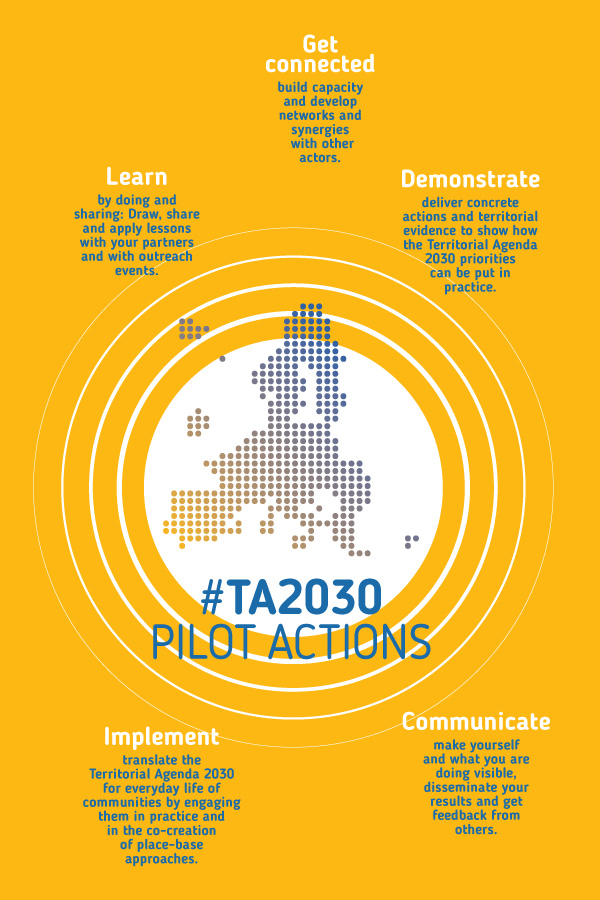 The priorities spelled out in the Territorial Agenda 2030 need to be supported by actions from committed players. Only then can Territorial Agenda priorities and concerns over spatial inequalities and the transition towards a carbon/climate-neutral economy be addressed appropriately.
The priorities spelled out in the Territorial Agenda 2030 need to be supported by actions from committed players. Only then can Territorial Agenda priorities and concerns over spatial inequalities and the transition towards a carbon/climate-neutral economy be addressed appropriately.
Application of the Territorial Agenda relies on informal multilevel cooperation between Member States, sub-national authorities, the European Commission, the European Parliament, the European Committee of the Regions, the European Economic and Social Committee, the European Investment Bank and other relevant players. Application of the Territorial Agenda would benefit from cooperation with those in charge of the Urban Agenda, the New Leipzig Charter, EU Cohesion and Rural Development Policy, the implementation of the EU Recovery Plan and the EU macro-regional and sea basin strategies.
To inspire joint actions across Europe, pilot actions demonstrate, test and develop practices which contribute to achieving Territorial Agenda priorities. These actions mirror increasing recognition of the importance of place-based policies by showing how the territorial dimension of regional, national and European policies can be actively addressed.
They focus on learning, sharing best practices, joint working groups developing ways forward, or implementation. Everybody is encouraged to closely follow these actions, take inspiration and offer proposals for new actions. Actions addressing priorities of the Urban Agenda, New Leipzig Charter and Territorial Agenda can strengthen links between urban and territorial policies.
Learning from ongoing examples

Applying the Territorial Agenda 2030 may appear demanding but it is important to note that significant benefits are already being achieved through the strategic use of existing resources. Governance structures can determine the optimal mix of investment priorities and achieve the necessary vertical and horizontal coordination to design and deliver integrated development strategies. Different geographical approaches, for example via functional urban areas, cross-border areas, urban-rural linkages etc., can develop innovative solutions to common challenges and unlock new potentials. Opening up the process of developing policy interventions to a broader range of territorial stakeholders can identify new ideas, financial sources and administrative capacities.
Against this background, the report ‘Implementing the Territorial Agenda 2030: Examples for a territorial approach in policy design and delivery‘ highlights previous or existing projects, initiatives and instruments that pursue a territorial approach. Its objectives are to demonstrate what has already been achieved, raise awareness of the benefits gained, and provide insights for pursuing the Territorial Agenda in practice. It covers 52 examples, presented in the report’s annex, that were collected across Europe from a variety of thematic, institutional and geographical contexts. These were selected to illustrate different aspects of the territorial approach in policy design and delivery and draw out key insights rather than demonstrate best practices. The examples portray the diversity of ongoing activities, yet all have implicit or explicit linkages with the objectives and priorities of the Territorial Agenda 2030.
Dedicated actions in the making
 Together with the adoption of the Territorial Agenda 2030, six dedicated pilot actions have been launched. They mirror the increasing recognition of the importance of place-based policies by showing how the territorial dimension of regional, national and European policies can be actively addressed.
Together with the adoption of the Territorial Agenda 2030, six dedicated pilot actions have been launched. They mirror the increasing recognition of the importance of place-based policies by showing how the territorial dimension of regional, national and European policies can be actively addressed.
The participation in a pilot action should be a win-win relation between what you get and what you can bring to a pilot action.
- Learn by doing and sharing: Draw, share and apply lessons with your partners and with outreach events.
- Get connected: build capacity and develop networks and synergies with other actors.
- Demonstrate: deliver concrete actions and territorial evidence to show how the Territorial Agenda 2030 priorities can be put in practice.
- Communicate: Make yourself and what you are doing visible, disseminate your results and get feedback from others.
- Implement: translate the Territorial Agenda 2030 for everyday life of communities by engaging them in practice and in the co-creation of place-base approaches.

